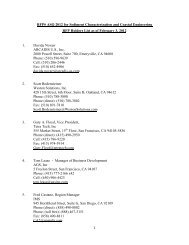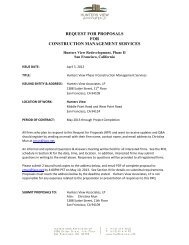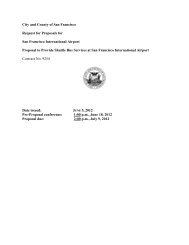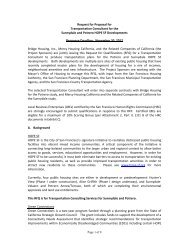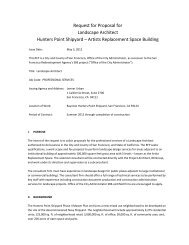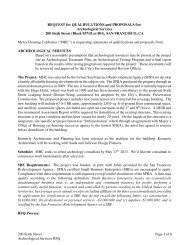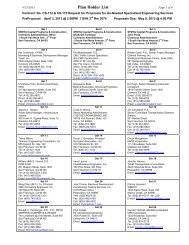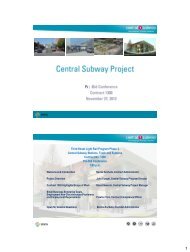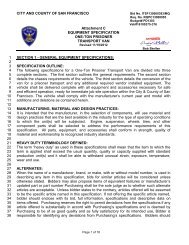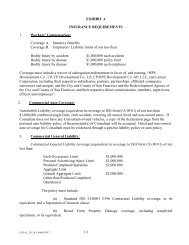Transbay Redevelopment Project Area
Transbay Redevelopment Project Area
Transbay Redevelopment Project Area
You also want an ePaper? Increase the reach of your titles
YUMPU automatically turns print PDFs into web optimized ePapers that Google loves.
BACKGROUND<br />
The <strong>Transbay</strong> <strong>Redevelopment</strong> <strong>Project</strong> <strong>Area</strong> is a 40-acre redevelopment district at the<br />
foot of Rincon Hill which includes the <strong>Transbay</strong> Transit Center (under construction) and<br />
approximately 12 acres of vacant public land. The <strong>Project</strong> <strong>Area</strong>, as depicted in Figure<br />
1 on page 2.6, was established in June 2005 with the adoption of the <strong>Redevelopment</strong><br />
Plan by the City and County of San Francisco.<br />
Pursuant to State Assembly Bill AB 26, redevelopment agencies throughout the State of<br />
California were eliminated on February 1, 2012. However, AB 26, as modified by AB 1484,<br />
allows the Successor Agency and MOH to continue to implement the former Agency’s<br />
enforceable obligations for the <strong>Project</strong> <strong>Area</strong>, including various interagency agreements<br />
that constitute the redevelopment program for <strong>Transbay</strong>. The <strong>Redevelopment</strong> Plan and<br />
related documents continue to govern the development of the <strong>Project</strong> <strong>Area</strong>.<br />
A. THE DISSOLUTION OF CALIFORNIA REDEVELOPMENT<br />
AGENCIES<br />
On June 28, 2011, the Governor of the State of California (“State”) approved<br />
two bills, AB 26 and State Assembly Bill AB 27 (“AB 27”), which amended the<br />
California Community <strong>Redevelopment</strong> Law (“CRL”), which regulates the activities of<br />
redevelopment agencies. AB 26 was the “dissolution” bill, which set November 1,<br />
2011as the date to dissolve all redevelopment agencies. The companion legislation<br />
AB 27, the “reinstatement” bill, allowed cities to keep their agencies in place by<br />
committing to substantial “community remittances” to be paid to the State.<br />
AB 26 put the Agency into a state of suspension under which no new contracts,<br />
obligations or redevelopment plans could be approved. In July 2011, a lawsuit was<br />
filed challenging the constitutionality of both AB 26 and AB 27. The Supreme Court<br />
accepted the case and issued a “stay” under which agencies remained in place but<br />
in a suspended state pending a decision by the court.<br />
On December 29, 2011, the California Supreme Court issued its decision: it upheld AB<br />
26, which eliminates redevelopment agencies, but struck down AB 27, which would<br />
have allowed cities to agree to community remittance payments to keep their agencies<br />
in place. As a result, under the schedule set by the Supreme Court, the Agency was<br />
dissolved as of February 1, 2012. AB 26 provides that a successor agency to the<br />
Agency could continue to implement “enforceable obligations” which were in place<br />
Block 9 : <strong>Transbay</strong> <strong>Redevelopment</strong> <strong>Project</strong> <strong>Area</strong> BACKGROUND | 2.1




